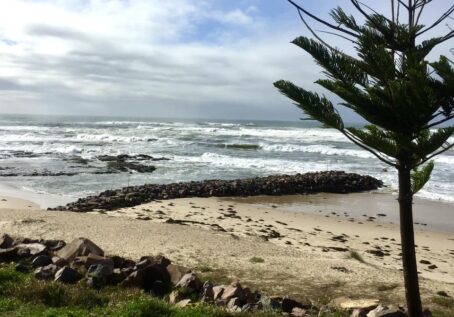
Council staff have recommended removing The Entrance Beach Groyne, listing a number of reasons why it should go.
These include increased erosion of the southern shoreline north of the structure; increased risk to Council’s seawall built to stabilise Marine Parade; and changes in flow that have significantly impacted Council’s ability to successfully manage the entrance for flood mitigations purposes.
“It is the view of Council staff that the impacts are, on balance, adverse and that the trial be concluded, with the groyne removed to reinstate natural processes,” a report to the Catchments to Coast Advisory Committee stated.
The staff recommendation was discussed at the final meeting of the committee, one of many committees that are finishing up because their terms end before the council elections in September.
The June meeting adopted the recommendation that the Committee “notes with concern the range of the negative impacts of the Groyne at The Entrance Channel and believes that the time for monitoring of the Groyne has passed and recommends that Council approach the NSW Government to find a solution”.
The committee’s recommendation will go to a future meeting, possibly the July meeting, of Council-under-administration for any further action but the report noted that Council has already written to the NSW Minister for Transport and Minister for the Environment expressing the views of Council staff.
In 2017 the NSW Government constructed a rock groyne on the Entrance Beach to the south of the entrance to Tuggerah Lakes, against the advice from Central Coast Council and the (previous) NSW Coastal Panel at the time, the report to the committee stated.
“The NSW Coastal Panel recommended that the groyne be viewed as:
“in the context of a short-term (say 10 year) trial with appropriate monitoring in order to highlight and re-dress any unintended adverse outcomes that might arise from the placement of a groyne structure in this location”, the report said.
Since the construction of the groyne in 2017, Council staff said in the report that they have observed adverse impacts progressively over time correlating with depletion of the average pre-groyne profile and conditions.
These changes significantly impacted Council’s ability to successfully manage the entrance for flood mitigations purposes.
“Since Tuggerah Lakes flooding in February 2020 and subsequent flooding there has been an increased need for entrance management operations to help train the entrance further to the north away from the rock shelf and groyne so that it can then scour into a wide and deep channel,” the report stated.
“Previously the need to have to intervene was very rare, normally only associated with managing a complete entrance closure.”
Council said it was now more difficult and required significantly more effort to redirect flow to berm areas where it can scour effectively.
“It’s suspected this constrained position may increase flood risk, peak flood levels and durations of elevated water levels where it cannot be successfully adjusted,” the report stated.
“The uncertainty relating to the full extent and significance of longer-term adverse impacts and what actions the NSW Government will take for rectification is now impacting the delivery of State-supported grant projects; the Tuggerah Lakes Flood Study Review and the Tuggerah Lakes Coastal Management Program,” Council stated.
“These are intended to set the long-term strategy for the coordinated management of the coast and floodplain and their reliability is critical for all involved stakeholders.”
It was the view of Council staff that the impacts were, on balance, adverse and that the trial should be concluded, with the groyne removed to reinstate natural processes.


